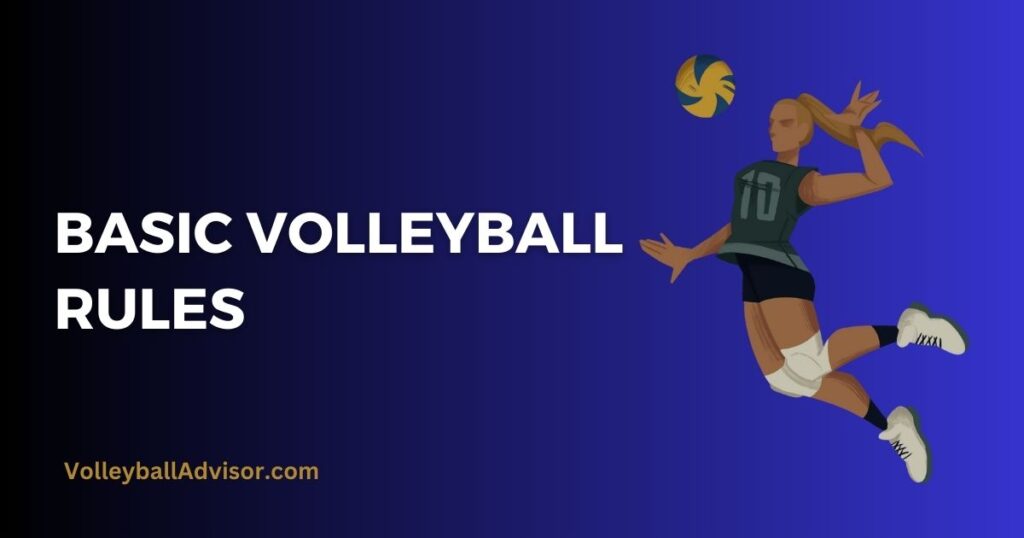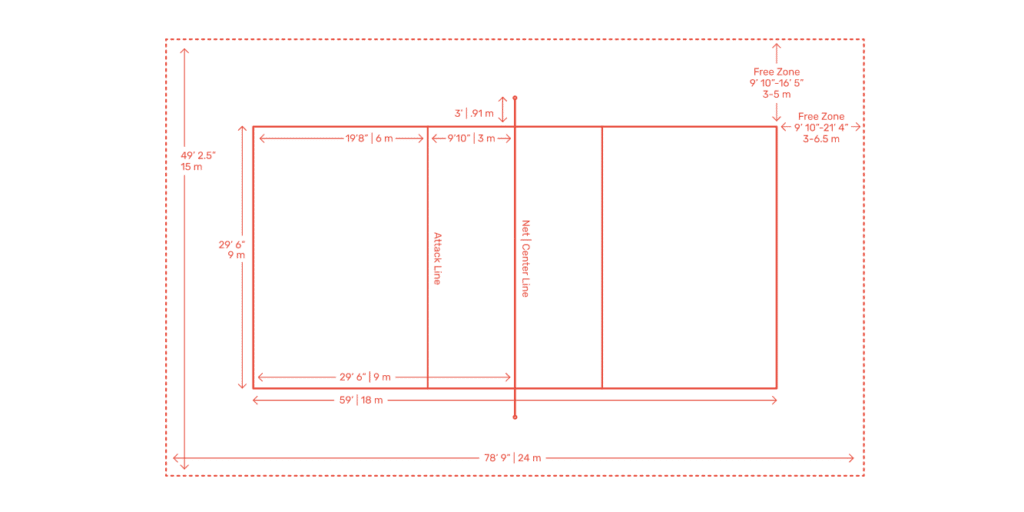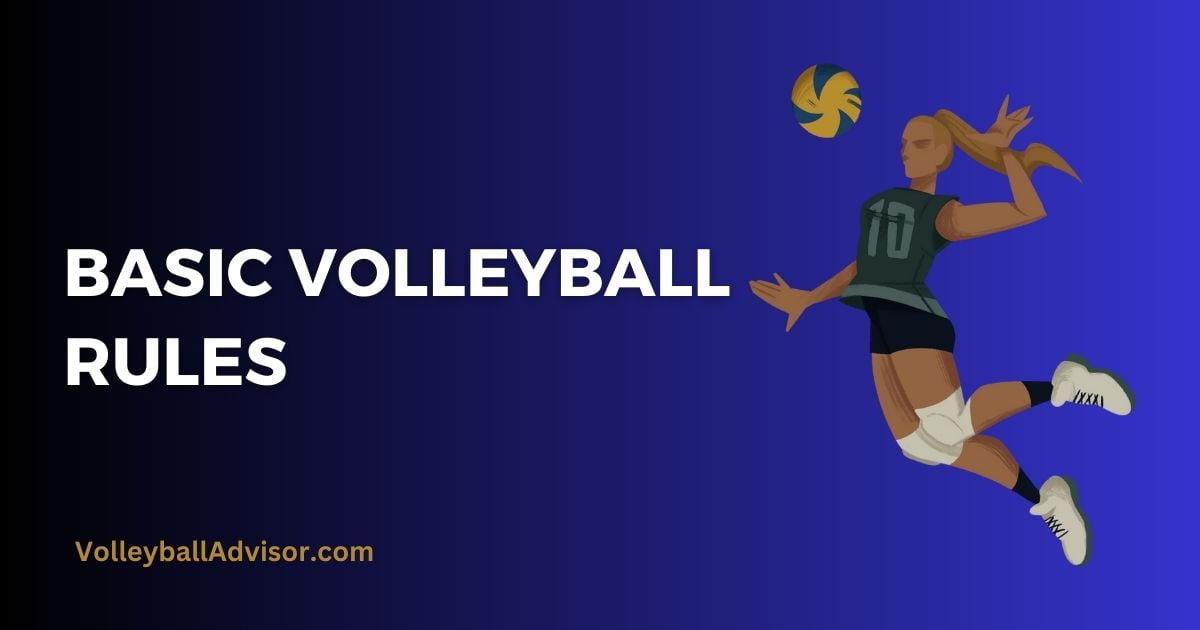Understanding the Basic Volleyball Rules is crucial for players, coaches, and enthusiasts alike. A firm grasp of the rules enables players to develop effective strategies, avoid penalties, and engage in fair play.
Coaches can better train and guide their teams, while spectators can appreciate the nuances of the game and follow the action with ease.

Moreover, knowing the rules is essential for maintaining safety and fostering sportsmanship among participants.
This article will provide a comprehensive guide to the rules of volleyball, covering everything from the basic objective of the game to more advanced techniques and strategies.
It will discuss the court, players, and positions, as well as the structure of a match, rotation, and substitution rules.
Additionally, the article will delve into specific aspects of the game, such as serving, attacking, blocking, digging, and setting.
The role of the libero and other specialized positions will also be explored, along with officiating and variations of the sport, like beach volleyball and sitting volleyball.
Basic Volleyball Rules
By the end of this guide, readers will have a solid understanding of volleyball rules and be better equipped to enjoy and participate in the sport.
- Each team consists of six players on the court, divided into front-row and back-row positions.
- The objective of the game is to score points by sending the ball over the net and landing it in the opponent’s court.
- Teams can make a maximum of three contacts with the ball before sending it over the net.
- Players are not allowed to hit the ball twice in a row, except during the first contact when a player can make consecutive contacts provided they occur during a single attempt to play the ball.
- A point is scored when the opposing team fails to return the ball legally, commits a fault, or receives a penalty.
- The team that scores a point serves the next rally.
- Players rotate clockwise around the court after each side-out (when the team wins the serve back from the opponent).
- The server must initiate the serve from behind the end line, within the boundaries of the court’s width.
- The served ball must travel over the net without touching the net or any antennas and land within the opponent’s court boundaries.
- Players may not attack or block the served ball while it is entirely above the height of the net.
- The ball may touch any part of the body, but players cannot make contact with the ball using their fingers and palms simultaneously (known as a “carry” or “lift”).
- Crossing the centerline under the net, touching the net, or touching the opponent’s court with any part of the body, except the feet, is not allowed.
- A player may not step on or over the attack line when initiating a back-row attack.
- A libero is a back-row defensive specialist who can replace any back-row player without counting toward the team’s substitution limitations.
- Each team is allowed six substitutions per set and two timeouts per set.
- Matches are typically best-of-five sets, with each set played to 25 points (except for the fifth set, which is played to 15 points), and a team must win by a margin of at least two points.
The objective of the Game
The primary objective of volleyball is for one team to score points by grounding the ball on the opponent’s court, while simultaneously preventing the opposing team from doing the same.
Teams achieve this by strategically passing, setting, and attacking the ball over the net without committing any violations.
The first team to reach the predetermined number of points, with a minimum two-point advantage, wins the set.
A match typically consists of the best of three or five sets.
Court Dimensions and Markings Rules

A standard indoor volleyball court measures 18 meters long and 9 meters wide, divided equally into two 9×9 meter halves by a net. The net height is 2.43 meters for men and 2.24 meters for women. The court features several markings, including:
- Sidelines and end lines: The outer boundaries of the court.
- Attack line: A line that is 3 meters from and parallel to the net on each side, separating the front and back zones.
- Centerline: A line under the net that marks the boundary between the two teams’ courts.
- Antennas: Vertical rods attached to the net, marking the boundaries for legal ball crossing.
Players and Positions Rules
Six Players per Team
Each volleyball team consists of six players on the court at any given time during a match. These players are divided into two rows:
- Front row: Comprised of three players positioned closest to the net, responsible for attacking, blocking, and setting.
- Back row: Comprised of three players positioned behind the front row, responsible for defense, serve reception, and back-row attacks.
Player Positions
Each team consists of six players, divided into three front-row and three back-row positions:
- Outside Hitter (OH): A front-row attacker who specializes in hitting from the left side of the court.
- Middle Blocker (MB): A front-row player who focuses on blocking the opponent’s attacks and hitting quick sets.
- Opposite Hitter (OPP): A front-row attacker who plays on the right side of the court and often serves as a secondary setter.
- Setter (S): The player responsible for setting up attacks by delivering the ball to hitters.
- Libero: A specialized defensive player who wears a contrasting jersey and is limited to back-row duties, mainly passing and digging.
- Defensive Specialist (DS): A player who specializes in back-row defense and may substitute in for weaker defensive front-row players.
Read More about Volleyball Positions Here.
Scoring System Rules
Volleyball uses a rally scoring system, where a point is awarded on every play, regardless of which team serves.
A team scores a point if the opponent commits a violation, fails to return the ball, or sends the ball out of bounds.
A standard indoor volleyball set is played to 25 points, with a minimum two-point advantage required to win.
The deciding set (third or fifth, depending on the format) is typically played to 15 points, again with a two-point advantage.
Volleyball Weight And Net Height Rules
The essential equipment for a volleyball game includes:
- Volleyball: A spherical ball made of leather or synthetic material with a circumference of 65-67 cm and a weight of 260-280 grams.
- Net: A mesh barrier, 1 meter wide and 9.5 to 10 meters long, that separates the two halves of the court.
- Antennas: Two vertical rods attached to the net, marking the boundaries for legal ball crossing.
- Knee pads and appropriate footwear: Protective gear and shoes designed for indoor court surface to ensure player safety and optimal performance.
Rotation and Substitution Rules
Volleyball Rotation Rules
- Teams rotate clockwise in one position after winning a point when they were not the serving team.
- This rotation ensures that all players on the court serve and occupy different positions throughout the match.
- The server for each rotation must serve from behind the end line and between the sidelines.
Volleyball Substitution Rules
- Each team is allowed a maximum of six substitutions per set, with certain limitations on player re-entry.
- A player can only re-enter the game in the same rotation position in which they were previously substituted out.
- The libero, however, is exempt from these substitution rules and can replace any back-row player without counting towards the team’s substitution count.
Timeouts and Intervals Rules
- Regular timeouts: Each team is allowed two 30-second timeouts per set. Timeouts can be requested by the coach or the captain when the ball is not in play.
- Technical timeouts: In some competitions, two additional technical timeouts are automatically applied, one when the first team reaches eight points and another when the first team reaches 16 points. These technical timeouts are 60 seconds long.
- Intervals: A 3-minute interval is allowed between sets, giving teams time to rest, strategize, and switch sides of the court. In some tournaments, a 10-minute break may be allowed between the second and third sets, especially in best-of-five matches.
Volleyball Service Rules and Violations
- Server position: The server must stand behind the end line and between the sidelines when initiating the serve.
- Serving order: Players must serve in the order established by the team’s rotation.
- Time to serve: The server has eight seconds from the referee’s whistle to initiate the serve.
- Foot fault: A foot fault occurs if the server steps on or over the end line before contacting the ball.
- Illegal contact: The server must strike the ball cleanly with one hand. Scooping, lifting, or pushing the ball during the serve is not allowed.
- Out-of-rotation: Teams must maintain their rotational order while serving. An out-of-rotation violation occurs if players are not in their correct positions when the ball is served.
Volleyball Receiving and Passing the Serve Rules
- Formations: Teams adopt different serve-receive formations, typically involving three passers, to cover the court and efficiently pass the ball to the setter.
- No attacking the serve: Players on the receiving team are not allowed to attack the serve by jumping and hitting the ball when it is entirely above the height of the net.
- First contact: The receiving team has a maximum of three contacts to return the ball over the net. The first contact, usually a pass or a dig, should direct the ball towards the setter.
- Double contact: During the first contact, a player may make consecutive contacts with the ball, provided the contacts occur during a single attempt to play the ball. This rule does not apply to the other two contacts.
Attack Rules and Violations
- Back-row attack: A back-row player is not allowed to jump and hit the ball from the front zone (in front of the attack line) when the ball is entirely above the height of the net.
- Crossing the centerline: An attacker’s foot must not completely cross the centerline under the net while attacking.
- Attacking the serve: Players cannot attack a serve by jumping and hitting the ball when it is entirely above the height of the net.
- Illegal contact: The ball must be cleanly hit, and prolonged contact or carrying the ball is not allowed.
- Hitting the antenna or out-of-bounds: An attack that hits the antenna or goes out-of-bounds without touching an opponent is considered a violation.
Block Rules and Violations
- Reaching over the net: Blockers are allowed to reach over the net to block an attack, but they cannot contact the ball until the attacker has made contact.
- Touching the net: A blocker is not allowed to touch the net during a block attempt.
- Blocking the serve: Players are not allowed to block or attack an opponent’s serve.
- Crossing the centerline: A blocker’s foot must not completely cross the centerline under the net while blocking.
- Back-row block: A back-row player is not allowed to participate in a block or attempt to block while jumping in the front zone.
Digging Rules and Violations
- Double contact: During the first contact, a player may make consecutive contacts with the ball, provided the contacts occur during a single attempt to play the ball. This rule does not apply to the other two contacts.
- Illegal contact: Prolonged contact or carrying the ball is not allowed. The ball must be cleanly contacted during the dig.
- Crossing the centerline: A player’s foot must not completely cross the centerline under the net while digging.
Setting Rules and Violations
- Double contact: A setter must contact the ball cleanly and simultaneously with both hands. Consecutive contacts, even if unintentional, are considered a violation.
- Illegal contact: Prolonged contact or carrying the ball is not allowed during a set.
- Over-the-net setting: When setting the ball over the net, the setter must not make contact with the ball entirely above the height of the net, unless directing the ball to their own court. Additionally, the ball must not cross the net outside the antenna on the opponent’s side.
- Back-row setting: A back-row setter can jump and set the ball from the front zone, provided they do not attempt an attack or block while the ball is entirely above the height of the net.
Libero Substitution and Rotation Rules
- Unique jersey: The libero wears a contrasting jersey to distinguish them from the other players on the team.
- Unlimited substitutions: The libero can freely replace any back-row player without counting towards the team’s six allotted substitutions per set.
- No front-row play: The libero is not allowed to play in the front row, attack the ball when it is entirely above the height of the net, or participate in blocking or attempting to block.
- No serving (with exceptions): In most competitions, the libero is not allowed to serve. However, certain leagues and tournaments allow the libero to serve for one rotation.
Conclusion
In conclusion, understanding the rules of volleyball is crucial for players, coaches, and fans alike.
From the basics such as court dimensions, player positions, and scoring system to more advanced concepts like serving techniques, attacking strategies, and officiating, a comprehensive knowledge of the game’s rules ensures fair play and enhances the enjoyment of the sport.
By adhering to these rules, players can focus on improving their skills and teamwork, while coaches can develop effective game strategies.
Ultimately, a solid grasp of volleyball’s rules fosters a more competitive and enjoyable experience for all involved.
